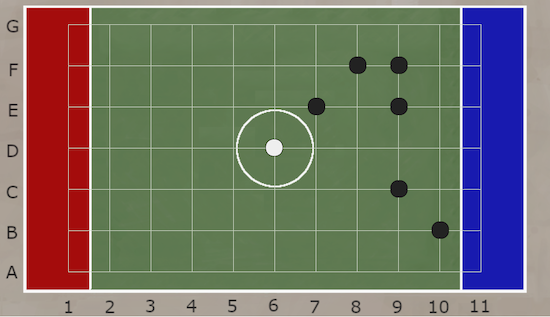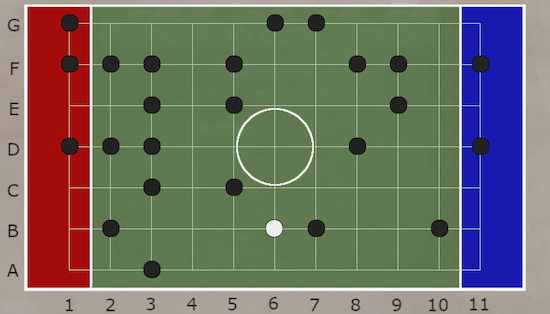Or search by topic
Number and algebra
Geometry and measure
Probability and statistics
Working mathematically
Advanced mathematics
For younger learners
Phiddlywinks



- Game
- Getting Started
- Teachers' Resources
Why play this game?
The article Phiddlywinks - a Tribute to John Conway outlines the background to the creation of this game and the thinking that it prompts. This game could be introduced at the same time as students are learning about coordinates.
Introducing the game
Demonstrate the game using the interactivity, perhaps with the class playing against the computer intially (the default version). This could be followed up by discussing the three scenarios pictured below:
Scenario 1: Player 1 to go next

Player 1 clicks on 7E (or 8F) and the white counter will move to 9G
Player 1 clicks on 9F (or 9E) and the white counter will move to 9D
Player 1 clicks on 9C and the white counter will move to 9B
Player 1 clicks on 10B and the white counter will move to 11B, winning the game!
Scenario 2: Player 2 to go next

Player 2's first move is to click on 5C, which will move the white counter to 4D
Player 2 now has two options for winning:
Either click on 3D (or 2D or 1D) and the white counter will move into the red region, winning the game
Or, click on 3C (or 2B) and the white counter will move to 1A, also winning the game.
Note that Player 2's second move cannot hop over the black counters at 3E, 2F and 1G to win, because the white counter would end up off the board.
Scenario 3: Player 1 to go next

Player 1 clicks on 5C and the white counter will move to 4B
Player 1 clicks on 5B (or 6B) and the white counter will move to 7B
Player 1 clicks on 8C (or 9D or 10E) and the white counter will move to 11F, winning the game!
You may also like
Teddy Town
There are nine teddies in Teddy Town - three red, three blue and three yellow. There are also nine houses, three of each colour. Can you put them on the map of Teddy Town according to the rules?
Four Triangles Puzzle
Cut four triangles from a square as shown in the picture. How many different shapes can you make by fitting the four triangles back together?

